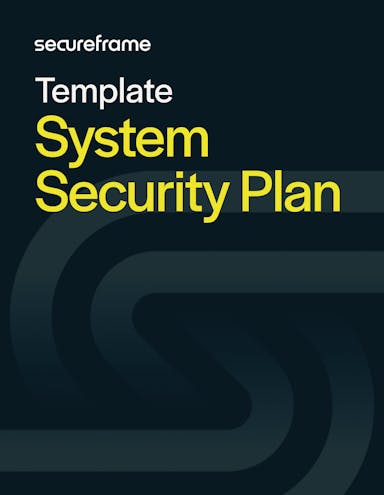Navigating the path to CMMC compliance can be challenging, particularly when it comes to understanding the various types of documentation required.
Proper documentation is not only essential for achieving CMMC certification but also for maintaining a strong cybersecurity posture within your organization.
Below we'll provide an overview of key CMMC documents to help you streamline your CMMC compliance efforts and ensure you're well-prepared for the assessment process.
CMMC System Security Plan (SSP)
The SSP outlines the cybersecurity practices and processes implemented to safeguard your information assets and IT infrastructure and meet the requirements of the CMMC framework. It provides a comprehensive overview of your organization’s information system, including
- a system description and boundaries
- risk assessment processes
- specific security controls
- policies and procedures
- incident response and continuous monitoring
- an overview of organizational roles and responsibilities
The SSP is essential for all CMMC certification levels. Assessors will review your SSP to understand how your organization meets CMMC requirements and manages and protects its sensitive data. A well-documented SSP can significantly streamline the assessment process and demonstrate your organization’s commitment to cybersecurity.

System Security Plan Template
Get a fully customizable SSP template that includes specific examples for each section for clear guidance on creating a compliant SSP.
CMMC Plan of Action and Milestones (POA&M)
The POA&M, also known as a Corrective Action Plan (CAM) document, is a strategic document used to identify and track the actions required to address gaps in your organization’s controls that were identified during an internal or third-party assessment.
By outlining any identified gaps as well as associated risks, planned remediation actions, timelines, milestones, and responsible parties, a POA&M provides a structured approach to address gaps, prioritize actions, and track progress toward achieving or maintaining compliance.

The POA&M should be a living document that is updated continuously, no less than monthly, as progress is made. As such, it’s crucial for demonstrating ongoing efforts to achieve and maintain CMMC compliance to third-party assessors, particularly for higher-level CMMC certifications where continuous improvement is emphasized.
Recommended reading

CMMC Documentation Templates
Read MoreOther CMMC compliance documentation examples
Policy, process, and procedure documents, training materials, plans and planning documents, and system-level, network, and data flow diagrams can all be used as evidence of compliance to applicable CMMC requirements.
Below are some key documents that may be reviewed as evidence during a CMMC assessment.
- Access control policy and procedures
- Audit and accountability policy and procedures
- Configuration management policy and procedures
- Continuous monitoring strategy
- Identification and authentication policy and procedures
- Incident response policy, plan, and procedures
- Password policy
- Personnel security policy and procedures
- Physical and environmental protection policy and procedures
- Risk assessment policy and procedures
- Security assessment and authorization policy and procedures
- Security planning policy
- System and communications protection policy and procedures
- System and information integrity policy and procedures
- System audit logs and records
- System maintenance policy and procedures
- System media protection policy and procedures
- System monitoring records
Please note this list is not exhaustive or prescriptive, although it does cover a range of practices required for CMMC compliance. For many of these practices, an assessor may examine the SSP rather than separate documents. Or, instead of documents, the assessor may examine mechanisms or activities, such viewing hardware or observing staff following a process, in order to assess whether a CMMC practice was met.
Preparing documentation for your auditor
Whether you're just beginning your CMMC journey or are in the process of certification, investing time and effort into these key documents will pay off by helping you achieve the level of security and compliance needed to succeed in the defense sector.
Getting this documentation organized will not only save you headaches and help you complete your audit on time — it will also allow your auditor to review documentation before they begin testing your controls.
Secureframe can help streamline the document management process. Secureframe automatically collects the evidence you need, maps it to the applicable controls and framework requirements, and stores it in a secure data room for easy, safe sharing with external auditors. You’ll get reminders to update evidence as needed annually for audits and be able to search for the exact document you need, or export filtered views as evidence.
Recommended reading

A Guide to Automated Evidence Collection for Compliance
Read MoreFAQs
What is the purpose of an SSP?
The SSP serves as a foundational document that describes how an organization’s information system is secured and how it meets the requirements of the CMMC framework. The SSP should go through each NIST 800-171 control and detail how all applicable controls are being implemented or planned to be implemented.
What is a CMMC POA&M?
A CMMC POA&M, or Plan of Action and Milestones, is a document that outlines how an organization will address and remediate cybersecurity deficiencies identified during a CMMC assessment. It includes specific actions, timelines, and milestones to correct these gaps, serving as a roadmap to achieve full compliance with CMMC requirements. The POA&M is crucial for systematically managing and prioritizing remediation efforts, especially for organizations aiming for higher CMMC certification levels where more rigorous security practices are required.
What documentation is needed for CMMC compliance?
For CMMC certification, organizations must provide several key documents that demonstrate their cybersecurity practices and processes that meet CMMC requirements. Essential documentation includes an SSP, a POA&M, and policies and procedures related to access control, incident response, risk assessment, and other key areas. These documents are crucial for both internal and external assessments conducted by assessors during the certification process.